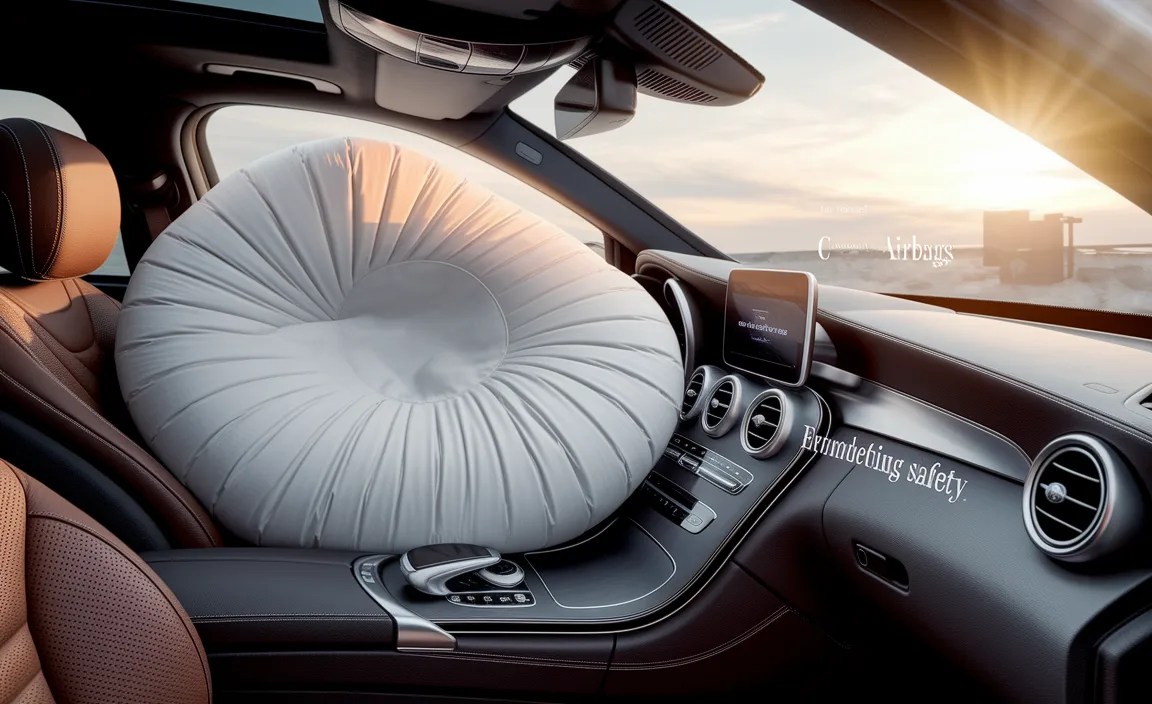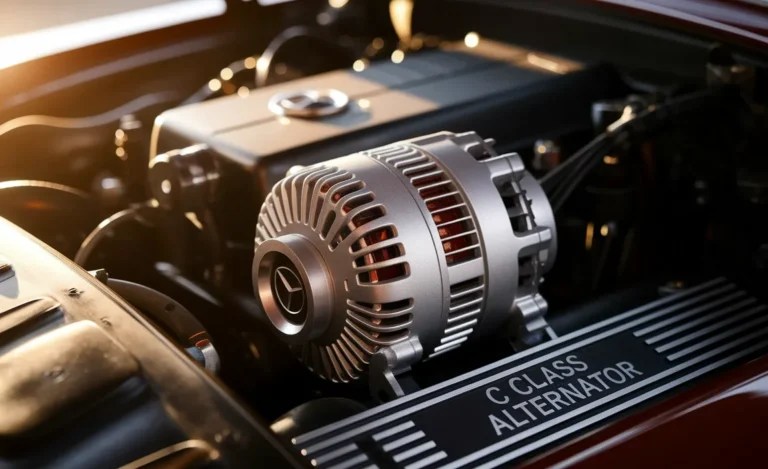C Class Airbags: Your Essential Safety Upgrade
C Class airbags are sophisticated safety systems designed to deploy instantly during a collision, significantly reducing the risk of severe injury to occupants. Understanding their function, types, and importance is key to appreciating your Mercedes-Benz C-Class’s commitment to your well-being.

When you think about the luxury and performance of your Mercedes-Benz C-Class, its advanced safety features often come to the forefront. Among these, the C-Class airbags stand out as a critical component, working silently until the moment they are needed most. These aren’t just simple bags; they represent a complex, finely tuned system engineered to protect you and your passengers. If you’ve ever felt a slight unease about how these systems function or if they’re working optimally, you’re not alone. Many owners wonder about the intricacies of airbag technology. This guide is designed to demystify C-Class airbags, explaining their technology, importance, and what you need to know to ensure they are always ready to perform their life-saving role. Let’s explore the engineering brilliance that safeguards your journeys.
Understanding C Class Airbags: More Than Just a Cushion
Your Mercedes-Benz C-Class is equipped with a comprehensive airbag system, designed to react instantaneously in a crash scenario. This system is far more advanced than early airbag technologies, incorporating features that adapt to the severity of an impact and the occupants’ positions. The primary goal is to create a protective buffer between passengers and the hard surfaces within the vehicle’s cabin, thus mitigating the forces exerted on the body during a collision.
The airbags are strategically placed throughout the vehicle, not just in the steering wheel and dashboard. This multi-point protection is a hallmark of Mercedes-Benz’s dedication to passenger safety, encompassing front, side, curtain, and even knee airbags, depending on the specific C-Class model and its year of manufacture. Each component works in harmony with the vehicle’s seatbelts and crumple zones to form an integrated safety cell.
The Science Behind the Deployment
When a collision occurs, sensors embedded within the C-Class detect rapid deceleration. This input is processed by the airbag control unit, a dedicated computer that analyzes the crash data in milliseconds. If the impact is severe enough to warrant deployment, the control unit sends an electrical signal to the airbag module. This signal ignites a small pyrotechnic charge, which rapidly generates a harmless gas (typically nitrogen). This gas inflates the airbag at extremely high speed – typically faster than the blink of an eye – creating a cushion that absorbs impact energy and prevents occupants from striking the vehicle’s interior.

It’s a marvel of automotive engineering, honed over decades to balance rapid deployment with occupant protection. The inflation rate and the material of the airbag itself are carefully calibrated to prevent injuries from the airbag deployment itself. Even the exhaust ports on the airbag are designed to let gas escape quickly after impact, allowing the occupant to regain visibility and move, if necessary.
Types of Airbags in Your C-Class
Modern C-Class vehicles boast an array of airbags, each designed to provide specific protection:
- Frontal Airbags: The most well-known, these are typically housed in the steering wheel (driver) and dashboard (passenger). They deploy in frontal or near-frontal collisions to protect the head and chest.
- Side Airbags: Usually integrated into the sides of the front seats, these protect the torso and pelvis in side-impact collisions.
- Curtain Airbags (Head Airbags): These deploy from the roofline along the windows of both the front and rear doors. Their primary function is to protect the heads of occupants in side-impact crashes and rollovers by creating a protective barrier.
- Knee Airbags: Often found beneath the dashboard on the driver’s side, these help to secure the occupant’s legs and prevent them from sliding under the dashboard during a frontal impact.
- Seatbelt Pretensioners: While not airbags themselves, they are a crucial part of the passive safety system. In a crash, they instantly tighten the seatbelts to hold occupants firmly in place, optimizing their position for airbag deployment.
The exact configuration of airbags can vary depending on the model year and trim level of your C-Class. Always refer to your owner’s manual for the precise details of your vehicle’s safety features.
The Importance of C Class Airbags for Your Safety
Airbags are not a supplementary feature; they are a core component of a vehicle’s safety architecture. Their importance cannot be overstated, as they work in conjunction with seatbelts to provide a comprehensive safety net. The National Highway Traffic Safety Administration (NHTSA) confirms that airbags, when used with seatbelts, significantly reduce the risk of fatalities and serious injuries in a crash.
Consider the forces involved in a collision. Even at moderate speeds, the occupant can be thrown forward with considerable momentum. Without airbags, this momentum could lead to severe impacts with the steering wheel, dashboard, or windshield. Airbags deploy to absorb a significant portion of this energy, cushioning the occupants and preventing or minimizing direct contact with rigid interior surfaces.
Beyond frontal impacts, side airbags and curtain airbags are vital for protecting occupants against the devastating forces of side-impact collisions, which often put occupants at higher risk due to the limited protection offered by side structures. A rollover event, while less common, can also be made significantly safer by the presence and proper function of curtain airbags.
Statistics Speak Volumes
NHTSA data consistently shows the life-saving impact of airbags. For instance, records indicate that frontal airbags alone have saved tens of thousands of lives since their widespread introduction in passenger vehicles. While specific statistics for C-Class models are not typically broken out individually, the underlying technology and its effectiveness are universal across vehicles equipped with advanced airbag systems like those in Mercedes-Benz.
A study by the Insurance Institute for Highway Safety (IIHS) also highlights the effectiveness of various airbag types in reducing different kinds of crash injuries. This underscores why ensuring your C-Class’s airbag system is fully operational is paramount. A well-maintained airbag system is an investment in your safety and peace of mind.
Maintaining Your C Class Airbag System: What Owners Need to Know
Your C-Class airbags are designed to be maintenance-free for the life of the vehicle under normal operating conditions. However, several factors can affect their performance or indicate a potential issue. The most common indicator is the airbag warning light on your dashboard.

The Airbag Warning Light: Your Indicator
The airbag warning light is a crucial part of your vehicle’s self-diagnostic system. When you start your C-Class, the airbag system runs a self-check, and the warning light should illuminate briefly and then turn off. If the light stays on, flashes, or illuminates while driving, it signifies that the airbag system has detected a fault.
This fault could be minor, such as a loose connection in a sensor or wiring harness, or it could indicate a more significant issue with an airbag module or the control unit. Regardless of the perceived severity, an illuminated airbag light means the airbag system may not deploy correctly in an accident, or it may deploy unintentionally. It is imperative to have this checked by a qualified technician immediately.
Common Causes for the Airbag Warning Light:
- Faulty seat occupancy sensor
- Damaged airbag wiring or connections
- Defective airbag module
- Issues with the seatbelt pretensioner
- Impact sensors malfunctioning
- Recent accident where airbags may have deployed or system was stressed
Professional Inspection is Key
Due to the complexity and critical nature of the airbag system, any malfunction should be diagnosed by a Mercedes-Benz dealership or a trusted independent mechanic specializing in Mercedes-Benz vehicles. They have the specialized diagnostic tools, such as the Mercedes-Benz STAR diagnostic system, needed to read fault codes and pinpoint the exact cause of the issue.
Trying to “fix” an airbag system without proper training and equipment can be extremely dangerous. High voltages are present in the system, and incorrect handling can lead to accidental deployment or disable the system entirely. Additionally, replacing airbag components requires specific procedures and genuine Mercedes-Benz parts to ensure proper function and compatibility.
Consider the following when seeking professional service:
- Use a Certified Technician: Look for technicians certified by Mercedes-Benz or with extensive experience working on the brand.
- Genuine Parts: Ensure any replaced components are genuine Mercedes-Benz parts to maintain the integrity of the safety system.
- Diagnostic Scan: A proper diagnostic scan is essential for identifying the root cause of any airbag fault.
Things to Avoid That Could Affect Your Airbags
While your airbags are robust, certain actions or conditions can inadvertently impact their performance:
- Modifying Seats: Altering seat covers, adding accessories that interfere with seat sensors, or placing objects on the seat can affect the seat occupancy sensor’s ability to function correctly, especially in models with occupant detection systems.
- Water Damage: Significant water ingress into the cabin can damage the electronic control unit and sensors.
- Electrical System Issues: Problems with the vehicle’s general electrical system can sometimes interfere with the airbag system’s diagnostics.
- DIY Repairs on Related Components: Tampering with the steering column, dashboard, or seat wiring without proper knowledge can lead to airbag system faults.
Understanding Airbag Replacement After an Accident
If your C-Class has been involved in an accident where the airbags deployed, it’s crucial to understand that the entire airbag system needs a thorough inspection and likely replacement. Deploying an airbag is a single-use event; they do not reset or reinflate.

After airbag deployment, the following components typically need to be replaced as part of a comprehensive repair:
- Airbag Modules: All deployed airbags (steering wheel, dashboard, side, curtain, etc.) need to be replaced with new units.
- Airbag Control Module (ACU): This is the “brain” of the system. In many cases, after deployment, the ACU needs to be reprogrammed or replaced to reset its internal crash data and ensure it’s functioning correctly with new components.
- Impact Sensors: These sensors, which trigger airbag deployment, may need replacement if they were damaged or if the system dictates it.
- Seatbelt Pretensioners: If the seatbelts were activated (tightened), their pretensioner mechanisms are typically a one-time-use item and will require replacement.
- Clock Spring: This is a coiled electrical connector located in the steering column that allows the steering wheel to turn while maintaining electrical connections for the airbag and horn. It often needs replacement after airbag deployment.
- Interior Trim: Dashboard panels, steering wheel covers, and other interior trim pieces that were designed to break open for airbag deployment will need to be replaced to restore the cabin’s appearance and integrity.
It’s essential to perform these repairs at a reputable body shop that understands the intricacies of Mercedes-Benz airbag systems. Improper repair can compromise the vehicle’s safety in future incidents. You can often find guidance on recommended repair practices from organizations like the Insurance Institute for Highway Safety (IIHS), which provides valuable research on automotive safety technologies.
Ensuring Your C-Class Airbags are Optimized: Tips for Buyers and Owners
Whether you are purchasing a new or pre-owned C-Class, or you are an owner looking to maintain your current vehicle, a few considerations can help ensure your airbag system is in optimal condition.
For New Car Buyers
khi comparing different C-Class trims and model years, pay attention to the descriptions of safety features. Mercedes-Benz typically equips all C-Class models with a comprehensive set of airbags, but there might be variations in advanced features like adaptive airbags or specific curtain airbag coverage on older models or base trims. Always verify the exact airbag configuration with the salesperson or by consulting the vehicle’s window sticker or official specifications.
For Pre-Owned C-Class Buyers
This is where vigilance is crucial. Airbags are a critical safety feature, and their condition cannot be visually inspected easily. When buying a used C-Class:
- Check the Service History: Look for records of any accidents, especially those where airbags may have deployed. If the vehicle has been in a significant collision, inquire about how the airbag system was repaired.
- Inspect the Airbag Warning Light: Before finalizing your purchase, turn the ignition to the ‘on’ position (without starting the engine). The airbag warning light should illuminate. Start the engine, and the light should extinguish within a few seconds. If it stays on, flashes, or does not illuminate at all, it’s a major red flag. Do not proceed with the purchase without having this thoroughly inspected and rectified by a certified technician, preferably at your own expense or by negotiating its repair with the seller.
- Professional Pre-Purchase Inspection: Highly recommend having a pre-purchase inspection done by an independent Mercedes-Benz specialist. They can put the vehicle on their diagnostic equipment and check for any airbag system fault codes.
Understand that replacing a deployed airbag system can be very expensive if not done correctly. A vehicle with an undeclared incident involving airbag deployment and improper repair may not offer the safety it promises.
For Current Owners
Regular maintenance is key. While the airbags themselves are passive, ensuring the system’s sensors, wiring, and control unit are in good health relies on overall vehicle maintenance. Your C-Class’s scheduled maintenance checks often include a review of the SRS (Supplemental Restraint System) warning light. If you ever notice the light illuminate, address it immediately with a qualified technician.
Key Maintenance Considerations:
- Follow Manufacturer’s Maintenance Schedule: This ensures all electronic systems, including diagnostics for the airbag system, are checked.
- Be Mindful of Interior Modifications: Avoid aftermarket accessories that might interfere with seat sensors or wiring.
- Report Any Unusual Behavior: If you notice any odd electrical behavior in the car, inform your mechanic, as it might indirectly relate to the SRS system.
What Does the C-Class Airbag System Protect Against?
The C-Class airbag system is engineered to provide protection across a range of collision scenarios. Its multi-stage deployment and strategic placement of airbags work to mitigate injuries from various impact types.
Primary Protection Scenarios:
- Frontal Collisions: The frontal airbags, combined with seatbelt pretensioners, are designed to cushion occupants from the dashboard and steering wheel during head-on impacts. Advanced systems may offer dual-stage deployment, meaning the airbags inflate with more or less force depending on the severity of the impact, providing a more tailored level of protection.
- Side Collisions: Side airbags (in the seats) and curtain airbags (from the roof) are vital for protecting the torso, pelvis, and head from the intrusion of another vehicle or object into the side of your C-Class. These are critical for preventing severe injury to vital organs and the head in one of the most dangerous types of crashes.
- Rollover Accidents: Curtain airbags play a significant role in rollover situations, helping to keep occupants contained within the protective shell of the vehicle and preventing ejection by cushioning heads against side structures throughout the duration of the event.
- Rear-end Collisions (Indirect Protection): While airbags are primarily designed for frontal and side impacts, systems like seatbelt pretensioners are vital in all collision types, including whiplash prevention, by restraining occupants and reducing forward momentum.
It’s important to remember that airbags are a supplementary restraint system (SRS). They work in tandem with your seatbelts. The greatest safety is achieved when both the seatbelt is properly worn and the airbag system is fully functional.
Frequently Asked Questions About C Class Airbags
Q1: How do I know if my C-Class airbags are working?
A: When you turn your C-Class ignition to the ‘on’ position, the airbag warning light on your dashboard will illuminate for a few seconds and then go out. If the light stays on, flashes, or never illuminates, there is an issue with the airbag system that needs immediate attention from a qualified technician.
Q2: Can I fix my C-Class airbags myself if the warning light is on?
A: No, it is strongly advised against attempting to repair airbag systems yourself. They are complex and dangerous if handled improperly. Always consult a professional technician with Mercedes-Benz expertise.
Q3: What happens to my C-Class airbags after an accident?
A: Once airbags have deployed, they are spent and cannot be reused. The entire affected airbag system, including modules, sensors, and potentially the control unit, will need to be inspected and replaced by a certified professional.
Q4: How often should C-Class airbags be replaced if they haven’t deployed?
A: Under normal circumstances, Mercedes-Benz designs airbags to last the lifetime of the vehicle. Replacement is only necessary if they have deployed in an accident or if a fault is detected by the vehicle’s diagnostic system.
Q5: Can aftermarket accessories affect my C-Class airbags?
A: Yes, some aftermarket accessories, especially those installed on or near the seats (like seat covers or electronic add-ons), can interfere with seat occupancy sensors and potentially cause airbag system faults or malfunctions.






